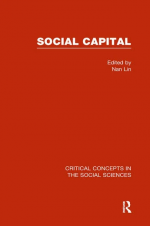Tab Article
‘Social capital’ is a major conceptual and theoretical idea that has received in the last three decades much attention across many social-science disciplines. In this relatively short period, it has developed into a major research paradigm guiding voluminous research conducted in North America, Europe, Asia, and elsewhere. Theory, measurement, and empirical research continue to grow. At the same time, major components of a theory, systematic research enterprises, and comprehensive applications in diverse substantive areas can now be identified in the literature. This new Routledge Major Work is a four-volume collection edited by a leading scholar who has brought together canonical and the very best cutting-edge research in the field.


